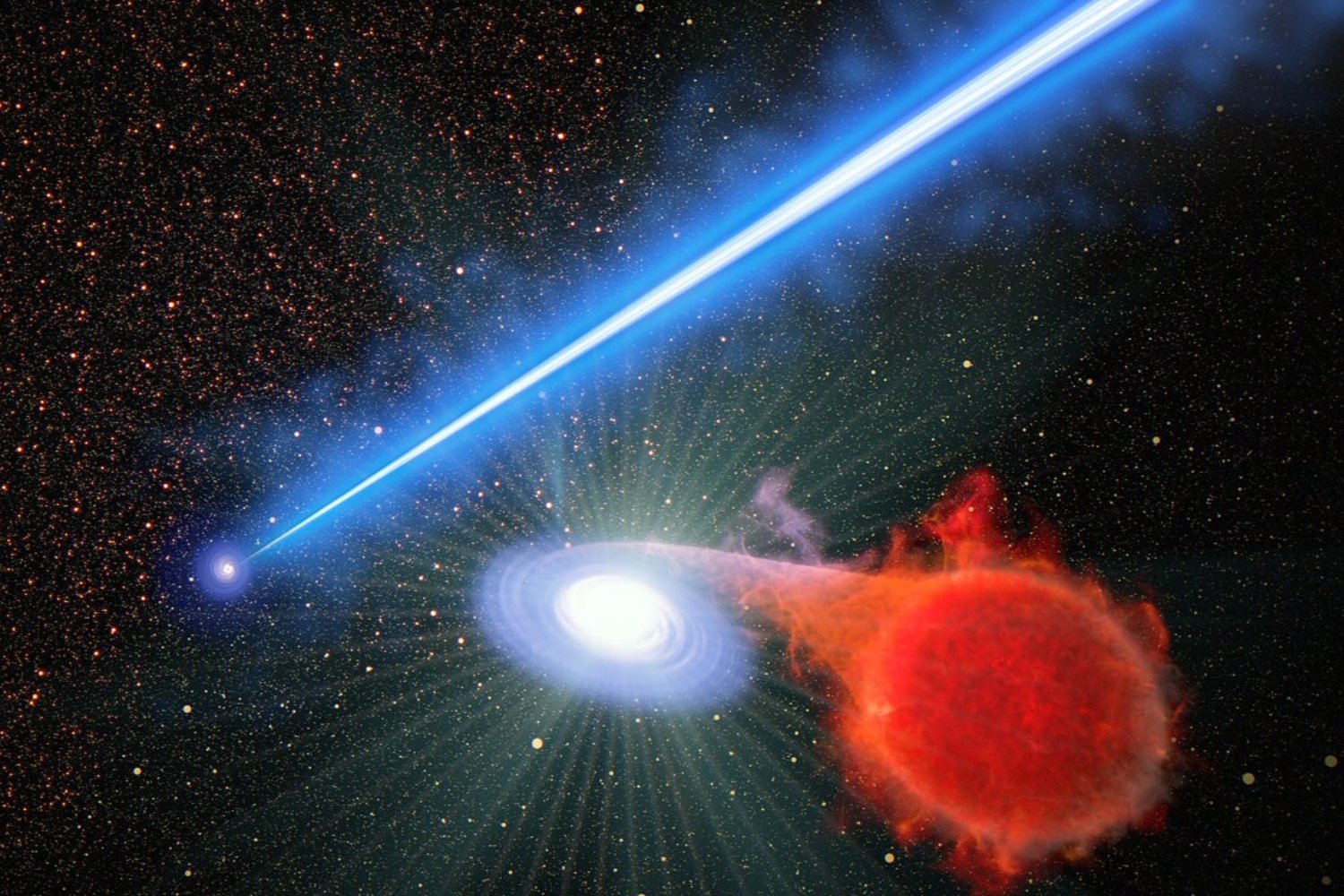Black hole jets, which spew near-light-speed particle beams, can trigger nearby white dwarf stars to explode by igniting hydrogen layers on their surfaces. “We don’t know what’s going on, but it’s just a very exciting finding,” said Alec Lessing, an astrophysicist at Stanford University and lead author of a new study describing the phenomenon, in an ESA release. Gizmodo reports:
In the recent work – set to publish in The Astrophysical Journal and is currently hosted on the preprint server arXiv – the team studied 135 novae in the galaxy M87, which hosts a supermassive black hole of the same name at its core. M87 is 6.5 billion times the mass of the Sun and was the first black hole to be directly imaged, in work done in 2019 by the Event Horizon Telescope Collaboration. The team found twice as many novae erupting near M87’s 3,000 light-year-long plasma jet than elsewhere in the galaxy. The Hubble Space Telescope also directly imaged M87’s jet, which you can see below in luminous blue detail. Though it looks fairly calm in the image, the distance deceives you: this is a long tendril of superheated, near-light speed particles, somehow triggering stars to erupt.
Though previous researchers had suggested there was more activity in the jet’s vicinity, new observations with Hubble’s wider-view cameras revealed more of the novae brightening – indicating they were blowing hydrogen up off their surface layers. “There’s something that the jet is doing to the star systems that wander into the surrounding neighborhood. Maybe the jet somehow snowplows hydrogen fuel onto the white dwarfs, causing them to erupt more frequently,” Lessing said in the release. “But it’s not clear that it’s a physical pushing. It could be the effect of the pressure of the light emanating from the jet. When you deliver hydrogen faster, you get eruptions faster.” The new Hubble images of M87 are also the deepest yet taken, thanks to the newer cameras on Hubble. Though the team wrote in the paper that there’s between a 0.1% to 1% chance that their observations can be chalked up to randomness, most signs point to the jet somehow catalyzing the stellar eruptions.
Well, it was known that these jets contain a shitload of energy. Why is anybody surprised that a direct hit causes devastating effects?
Now you will see the power of this fully operational battle singularity.
battle singularity.
Death star.
More like Star death.
Who’s downvoting this? The article is literally about black hole smiting dwarf stars with particle beams!
Tightarses exist everywhere.
Not a star.
What doesn’t make sense is how haven’t these primordial black holes accumulated to form massive objects that dominate the universe? The distribution of dark matter implies that it’s widely dispersed throughout the universe, amongst all other matter, but wouldn’t these primordial black holes have started to attract matter and grown in mass from 1 second after the Big Bang? Wouldn’t the vast majority of these proton sized black holes no longer be proton sized? Wouldn’t they have grown until they absorbed most visible matter in their vicinity? If this were true wouldn’t it mean most of the dark voids between galaxies and stars are actually gravitationally dominated by black holes of varying sizes? How could our observations to date have missed that? Wouldn’t pointing the JWST at any void show signs of infrared gravitational lensing? Oh god I’ve gone cross-eyed…
Edit:
“Even if you take into account clustering, the time scales for the merger are so long that they would only merge into really massive black holes over the entire age of the universe,” he continued.
If this were true, how have all the sub-atomic particles accumulated to form visible matter and galaxies? Do these black holes somehow have less mass than other particles? If so, how could they possibly make up most of the gravity in the universe — more gravity than all the visible matter — yet their gravity is so weak that they don’t accumulate into larger clusters?
Black holes don’t swallow everything around them for the same reason that the sun hasn’t swallowed all the planets. Outside of the event horizon, gravity still works normally and the fact that it’s a singularity doesn’t really matter. Gravitational capture usually involves multiple objects, because the trajectory has to get nudged for a collision to happen. A gaseous body collects mass at a faster rate than a black hole with the same mass.
I’m pretty sure they can “get full” and basically explode also.
Black holes? No. As far as we know, there is no limit to the mass of a black hole.
Not true. The upper limit is about 50 billion solar masses.
From wikipedia:
Supermassive black holes in any quasar or Active galactic nucleus appear to have a theoretical upper limit of physically around 50 billion solar masses as any mass above this slows growth to a crawl (the slowdown tends to start around 10 billion solar masses) and causes the unstable accretion disk surrounding the black hole to coalesce into stars that orbit it.
Ok a bit more I found.
The 5×10^10 number you referenced is the SMBH maximum mass for typically observed black holes. However, near the maximum prograde spin, given the age of the universe, a black hole would not have been able to accumulate more than 2.7×10^11 solar masses.
So, yes, a practical limit exists. But to point to OPs comment, no they will not explode.
I didn’t know that, but it makes sense that AGN would have a limit. Lemme look this up, we’re pretty close to my limit of astrophysics
My understanding is that black holes naturally evaporate, releasing energy and sometimes matter out through their polar jets. I believe this is called hawking radiation. Now proton sized black holes can exist (I believe we’ve created them in the LHC), but at that size, the hawking radiation makes the black hole evaporate extremely quickly, like within nano seconds.
In other words, tiny black holes are very short lived, they rarely have time to absorb more material and grow.
I don’t know how true it is, but I read in another thread recently that Planck mass is about the mass of an eyelash and also the minimum mass of a black hole. Below that mass the location of a particle isn’t localized enough for it to be a black hole. Also IIRC the Schwartzchild radius of such a black hole is something like twice Planck length.
This is an incomplete understanding of modern physics. Hawking radiation isn’t jets. Hawking radiation is when subatomic particles pop into existence and one is below the event horizon and can’t escape or anhillate and the other is above the event horizon and flies away which causes a loss of mass in the black hole due to conservation of energy.
We aren’t currently sure if micro black holes evaporate or can reach equilibrium at planck scales. Also we haven’t made any black holes at the LHC. You would need something like 10 billion times more energy for the LHC to form black holes.
physics. Hawking radiation isn’t jets. Hawking radiation is when subatomic particles pop into existence and one is below the event horizon
I don’t believe that’s correct. At least, the last time I looked into it, the sources I looked at specifically said that version is oversimplified to the point of just being wrong.
What source are you referring to? I’d like to read it as that would contradict everything I’ve ever read on hawking radiation.
It’s a bit more complicated than that - theoretically Hawking radiation would cause a black hole with no surrounding matter to evaporate over an extremely long period of time (we’re talking 10^10 to 10^100 years).
Additionally, micro black holes have been proven mathematically in the 14MeV range of LHC, but as far as experimental data goes, we have not observed the creation of a micro black hole. The main problem is that they would instantly annihilate (as in exactly 0 seconds) and would be indistinguishable from events already creating gamma rays.
This is so incredibly cool!
Also cool: that the Hubble is still giving us all of the marvelous discoveries 34 years after launch.
am layman, naivete inbound;
we keep finding all this cool new information about black holes and the things they actually do .
but all we ever seem to know about ‘dark matter’ is ‘its weighty’
with black holes still an option for the behaviors we are seeing accounted to ‘dark matter’ why are we bothering with another, seemingly ephemeral type of ‘matter’?
Black hole behavior has largely been theoretically explored. What’s neat with this discovery is that the particle jets interact with stars causing a Nova - this means that there is a way to measure black holes we have a harder time observing and use that in calculating mass of galaxies. This is important if black holes do contribute to what we consider Dark Matter.
Dark Matter is simply something with mass (therefore matter) that does not interact with electromagnetism. It doesn’t absorb light, it doesn’t emit light. Therefore “dark” and extremely hard to study. We know it exists because it does interact with gravity.
Undetectable black holes can contribute to this measured mass, and are great candidates for some of the dark matter. The problem remains that the dark matter interactions are not exclusively resolved by black holes passing through an area of space.
Am also layman, but my understanding is that “dark matter” is just kind of a placeholder for some unaccounted for mass that’s detectable by inference. i.e. we can’t see anything that would produce that gravity, but we can detect that something out there has mass.
with black holes still an option for the behaviors we are seeing accounted to ‘dark matter’ why are we bothering with another, seemingly ephemeral type of ‘matter’?
That’s actually a theory that’s gaining traction again. Primordial black holes left over from the Big Bang are one contender for “dark matter”:
https://www.space.com/tiny-black-holes-big-bang-prime-dark-matter-suspects
“Dark energy” is the placeholder. Dark matter is, as far as we can tell, real, actual matter that just doesn’t really interact with other matter or energy very much. But it still exerts gravity.
this makes sense, thanks!






